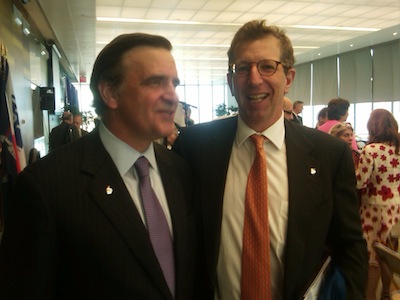by: admin

(l-r) Deputy Mayor Robert K. Steel and William C. Rudin
Rick Bell, FAIA
Robert K. Steel, Deputy Mayor for Economic Development, challenged a room full of civic leaders gathered at the new John Jay College of Criminal Justice Building to think “not about facilities, but what they facilitate” in strengthening New York City’s economic competitiveness. After a brief introduction by William C. Rudin, Chairman of the Association for a Better New York (ABNY), which hosted the June 21st breakfast, Steel outlined ways in which those coming together on the rooftop of the new City University of New York structure at 899 Tenth Avenue, designed by Skidmore, Owings & Merrill, could bolster the business climate and “encourage economic diversification, including investments in talent and in broadband infrastructure.”
He described the “four pillars of the city’s economic development” as:
* Improving the quality of life with public investments in parks, sanitation, culture, and schools;
* Creating a pro-business environment, making it clear that New York City is open for business;
* Investing in the future, with major redevelopment areas like Lower Manhattan, Downtown Brooklyn; and Long Island City;
* Fostering the idea that we have to be committed to innovation and game-changing initiatives.
The Deputy Mayor stated that “together, these four pillars provide a strong foundation for growth for the decades ahead,” and would create fertile soil for job creation by reforming the city’s bureaucracy. Of particular interest to the architects in the room was his description of ways in which processes of the Department of Buildings and the Department of City Planning were being reformed. Noting that it is now possible to apply for City permits online, rather than having to visit an office downtown, he cited the NYC Development Hub as a new mechanism to simplify operations.
The ABNY event was also billed as an opportunity to announce BluePRint, the initiative of the Department of City Planning. While the City’s ULURP process follows a predictable schedule, he noted that the much-maligned pre-certification process is being streamlined in an effort led by City Planning Chair Amanda Burden, Hon. AIANY, that will “make the process more efficient and predictable without sacrificing quality standards.” Process reform and more timely reviews have been long-time advocacy goals of the AIA New York Chapter. Deputy Mayor Steel said that “these improvements will save time and money for the developers and the City, getting projects onto the tax rolls sooner.
Steel gave as examples of upcoming change, the Bloomberg Administration’s work with the NYC Housing Authority to address long-standing operational deficits and maximize NYCHA’s real estate portfolio value. And he spoke of the transformative role of large-scale projects such as the Kingsbridge Armory and the Applied Science and Technion campuses. In describing neighborhood change across the city from Willets Point to Seward Park, he said that Mayor Bloomberg “is committed to creating the jobs of the future.”
The Deputy Mayor’s inspirational remarks concluded with a call to “keep investing in infrastructure and talent,” and, paraphrasing ABNY Founder Lew Rudin, “New York City’s best days lay ahead.” As for a question about design during the Q&A session, he said simply: “We can do more” – so keep tuned.
Rick Bell, FAIA, is the Executive Director of AIA New York.









